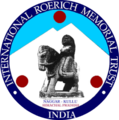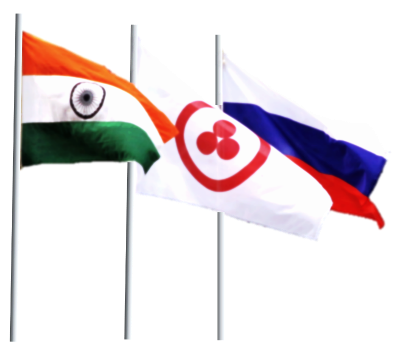29.05.2024
Enchanting patterns of Himachal culture by Hemlata Thakur
From 29 May to 2 June, the Exhibition Hall of the International Roerich Memorial Trust hosted an exhibition of the artist Hemlata Thakur from Manali. This was not the artist's first exhibition at the IRMT; her works are a favourite of the Trust's visitors.
Hemlata Thakur has resided in the vicinity of Manali throughout her life. The natural environment, cultural traditions, and local culture of Himachal Pradesh have been an integral part of her life and creative output.
The inaugural event of the exhibition was held on 29 May. The opening ceremony of the exhibition was attended by Mrs Larisa Surgina, Russian Curator of the IRMT and an employee of the ICR (Moscow), and her colleague, Indian Curator of the IRMT Mr Suresh Kumar.
The attendees of the exhibition were transported to the idyllic realm of Himachal culture, depicted with great affection by the artist in her canvases. Hemlata Thakur is a versatile artist who works in a variety of genres and techniques. She employs watercolour and acrylic paints in her artistic creations. The exhibition showcased a diverse range of artistic mediums, including canvas, paper, wood, and stone.
The artist's inspiration and material source for her works stem from the natural beauty of Himachal. It is somewhat surprising to learn that the artist in question has no formal art education. Her passion for painting was ignited at an early age. The artist's early experiences of rural life, including observations of her grandparents, parents, neighbours and the surrounding Himalayan landscape, inspired her to express her impressions through the medium of painting. This marked the commencement of the artist's artistic journey. Over time, her technique has evolved, yet her enduring passion for depicting simple scenes of village life, portraits of ordinary people, and her native Himachal culture has remained consistent.
The exhibition presents a diverse array of works that depict real individuals encountered by the artist in the ordinary course of daily life. The artist employs remarkable realism in her work, despite the seemingly simple technical methods she uses. In Hemlata's portraits, one is initially struck by the vividness and mood that pervade all the details. On occasion, the artist deliberately simplifies the background, employs incorrect perspective and schematic, almost childish, painting techniques in order to draw attention to the centre of the picture – a living person, with his feelings and emotions, to the joy of simple human communication, to the memorable moments of everyday life. The portraits of children are particularly affecting. The children's large eyes appear to reflect the entirety of the world, and their facial expressions are so vivid that the viewer is made to feel that the children's chubby cheeks are about to be touched by a sweet smile.
It is no coincidence that the exhibition was inaugurated at the Roerichs' estate in Naggar - for the Roerich family, the Kullu Valley became a home away from home, their karma bhumi - a place of work and creativity for the benefit of humanity. Hemlata Thakur's paintings have similar themes to those of Nicholas and Svetoslav Roerich: traditional architecture of the Kullu valley, portraits of local people, elements of local culture and beliefs, traditions, legends and myths, beauty and spirituality of local nature. Like the Roerichs, Hemlata Thakur seeks to preserve and transmit the beauty of traditional culture and protect its beautiful manifestations through her art. Her paintings serve as a message to the viewer: "Let us together see and preserve the beautiful things in the world around us!" The exhibition has once again drawn the attention of the residents and visitors of the state to the rich cultural heritage of Himachal.














In addition to the images of children, the artist's female images also convey a specific message to the viewer. The numerous portraits of women presented at the exhibition encompass a diverse range of subjects, from contemporary urban female figures in evening attire to vibrant portrayals of Himachal beauties of all ages in traditional garb. Each painting can be regarded as an ode to a woman, encapsulating her multifaceted existence, encompassing both the challenges and the beauty of her life. She is depicted as a creator, a mother, a keeper of culture and traditions, a homekeeper, and a figure constrained by circumstances, yet always inspiring and beautiful.
The exhibition also presents the artist's works in the styles of classical Indian painting and paintings devoted to themes related to the diverse religions of India. These works offer insights into the artist's reflections on the foundations of the universe and their creative, mythological embodiment. In these works, the realistic style is replaced by a figurative, schematic and simplified style. The restrained, natural tones are replaced by bright, pure colours, as if mythological subjects were being carved out of the fabric of everyday life. Such are the paintings depicting Bhagavan Buddha, Ganesha, and Shiva. The works in the exhibition are so seamlessly integrated with realistic depictions of Himachal village life and portraits of its inhabitants that the viewer is compelled to recognize that these subjects are not merely mythological entities detached from reality; rather, they are an integral and tangible aspect of the lives of these ordinary individuals depicted in the portraits. This is one cultural universe, manifesting in various forms, which represents a pervasive fabric of eternal existence reflected in the everyday.

























